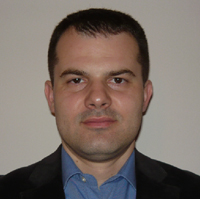
Nume: CHELARU Rafael
Tema: Creştinatate şi Islam
Partener: Institutul de Istorie Nicolae Iorga
Proiect: Between coexistence and assimilation: the Catholics of the sultan, the missionaries of the Propaganda and the Islam in South-eastern Europe (17th - 18th centuries)
Date de contact
raffdor@yahoo.com; rafael.chelaru@gmail.com
Curriculum Vitae
Position, institutional affiliation
Assistant Professor, “Al. I Cuza” Police Academy, Faculty of Archival Sciences (Bucharest, Romania)
Academic degrees:
- M.A. in Eastern European Medieval and Early Modern History awarded in 1999 by the University of Bucharest, Faculty of History.
- M.A. in Medieval Studies awarded in 2002 by Central European University, Medieval Studies Department (Budapest, Hungary)
- PhD in History awarded in 2009 by the University of Bucharest, Faculty of History following the accomplishment of the thesis entitled The Sacred Congregation "De Propaganda Fide" and the Catholic missionarism in Moldavia (17th and 18th c.)
Scholarships, research grants:
- 2007 - 2008: completion as project director of the research grant type PN II-TD no. 68, entitled The "De Propaganda Fide" Congregation and the Catholic Missionarism in Moldavia (17th and 18th centuries), awarded by the Romanian Ministry of Education, National University Research Council.
- 2008 –2010: member of the research team of the project type PCE, no. 298, entitled The Contribution of Ethnic and Confessional Minorities in the Development of the International Trade of the Romanian Principalities (second half of the 16th c. – the beginning of the 18th c.), coordinated by Assist. Professor Cristian Luca, Ph.D. (Lower Danube University, Faculty of History and Philosophy) and financed from public funds through the executive unit CNCSIS of the Ministry of Education, Research and Youth.
- 2009 – 2010: recipient of a ”Ştefan Odobleja” scholarship awarded by the New Europe College – Institute of Advanced Study (Bucharest, Romania).
Conferences:
Participation in international conferences and colloquia organized in Romania, Hungary, Italy, Czech Republic and Great Britain.
Between coexistence and assimilation: the Catholics of the sultan, the missionaries of the Propaganda and the Islam in South-eastern Europe (17th - 18th centuries)
Eastern Europe from 17th – 18th centuries represented for the Catholic missionaries both a challenge and a privileged territory for applying various reunification projects of the Christianity under the authority of the Roman Curia. The missionaries who activated in the Balkans (Bosnia, Croatia, Albania and Bulgaria) did not encounter a confessionally divided world, but a more fluid universe, where the religious identities were less defined, allowing the existence of areas of interferences where, for example, the Catholics and the Muslims practiced similar rituals and beliefs.
The main objective of my research project is to investigate and describe the “fluid” identities of the Catholics from the Western Balkan Peninsula (namely Albania, Bosnia, Dalmatia) between 17th and 18th centuries in relation with Islam.
To accomplish this, I need to address the following issues:
- the deconstruction of the adaptation mechanisms through which the Christian faithful, living in the same physical and community space with Muslims, built and administered their sphere of cohabitation in relation with the ”infidels”.
- the analysis of the parish as territorial expression of the Catholic community – due to its organization and demographical dynamic, it determined the relations with other communities, operated delimitations within mixed communities, created inter-communitary networks such as those linking communities from Bulgaria with others from Croatia or between Albania and Croatia (especially through the Ragusan merchants), determined some types of mobilities etc.
- the missionary discourse practiced in relation with the dynamic of the Catholic confessional identity. Within this frame, I intend to answer the following questions: a) How did the missionaries of the Propaganda Fide interact with this dynamic? b) To which extent were they active participants or not? and c) How they area of confluence were reflected in their correspondence with the “center” (not exclusively)?
The project is aimed to be interdisciplinary in its approach, using methods from various fields such as history, sociology of religion, anthropology.
Main publications:
- Colecţia Microfilme “Vatican”. Ghid arhivistic (”Vatican” Microfilm Collection. Guide), Bucharest: Ed. Arhivelor Naţionale ale României, 2007, 256 p.
- ”Venezia e l’attività missionaria cattolica nell’Europa Centro-Orientale duranti il XVII seccolo” L’Europa Centro-Orientale e la Penisola italiana: quattro secoli di rapporti e influssi intercorsi tra Stati e civiltà, edited by Cristian Luca and Gianluca Masi, Brăila-Venezia: Ed. Istros, 2007, 121-129.
- ”Towards a missionary geography: The lists of Moldavian Catholic parishes from the 17th and 18th centuries in the correspondence of the Propaganda Fide missionaries”.The Charm of a list. From the Sumerians to the Computerised Data Processing,, ed. Lucie Doležalova, Cambridge, Cambridge Scholars Publishing, 2009, 139-159.
- The Catholic Parishes in 17th – 18th century Moldavia (Diocese of Bacău): Economic Aspects, Transylvanian Review, nr. 1/2010: 96-106.
- Merchants and Catholic missionaries in the Romanian Principalities (17th–18th centuries), Istros, XVII (2011): 175-192.